If there is one club that is the envy of English football at present, then it’s Brighton. Not only do the Seagulls have a young, inventive manager and a team playing attractive football, but their player recruitment drive is raking in hefty transfer fees.
One of the summer’s transfer sagas was Moisés Caicedo’s move to Chelsea from Brighton, which was reportedly over £100 million. The South Coast side had initially bought the Ecuadorian for allegedly just £4.5 million. This is one of many examples of transfer deals that Tony Bloom’s club has been accustomed to of late, where young, unknown players have been bought cheaply, only to be sold on for a sizeable profit.
The means of identifying such unknown players have been achieved by taking advantage of vast amounts of data collected at all levels within world football. However, Brighton isn’t the only club utilising data for transfer market activity. Premier League rivals Brentford have long been advocates for using statistics and it was such methods that played a part in the West London side reaching England’s top flight and staying there.
Imagine a scenario of a side looking to play possession-based football in a 4-3-3 formation. In this data analysis, we will use overlooked statistics to create a starting XI of undervalued players who would conform to the tactics of the 4-3-3; all players considered for analysis will be under the age of 26 and not be currently commanding a large transfer fee.
Goalkeeper
In the modern game, it is often required of goalkeepers to be comfortable in possession. Whilst this is a desirable attribute, it should be a secondary thought to a keeper’s ability to save efforts. However, when considering a keeper’s save percentage, this may not be the most proactive.
For example, a keeper in a team that is high up the league is likely to be protected by a strong defence, and hence, efforts at goal may have a low expected goal value. This, in turn, suggests the keeper is more likely to make the save, increasing his save percentage value.
As a starting point, we have looked at the post-shot expected goal values (PSxG), which are the expected goals based on how likely the keeper is to save the shot. We have then deducted the goals conceded (including penalties) from the PSxG value.
From here, we assessed the secondary criteria, such as possession, and decided Famalicão, Luiz Júnior, makes our team.
At the time of writing, the 22-year-old Brazilian keeper had a PSxG value of 22.5, but when deducting the goals conceded, the Famalicão keeper’s value is +5.5, which is bettered only by Farense’s Ricardo Velho in Portugal’s top tier. Although Júnior does not rank top, his possessional play outperforms his Primeira Liga rival.
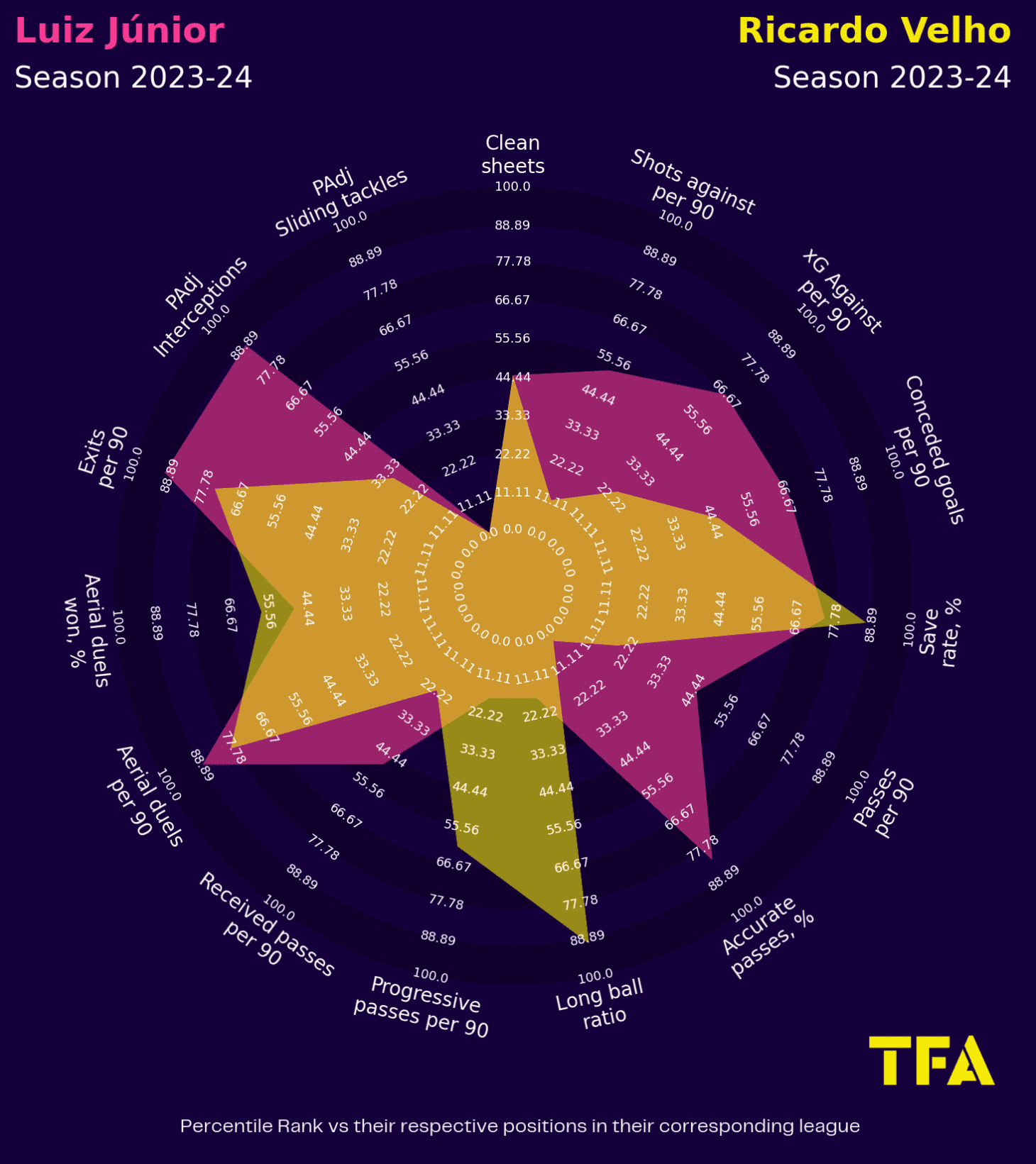
The radar chart shows that although similar save statistics between the two goalkeepers, Júnior is facing more shots per 90. While Velho does not concede as many goals, he tends to opt for a long ball upfield, which is not desirable for a side looking to play out from the back.
It is shown that Júnior is much more comfortable leaving the penalty area, further exemplifying his stronger possessional play. This, coupled with Velho being three years his senior, makes him a more appealing transfer option.
Defence
In a 4-3-3, the back four will be compact in their shape, with the full-backs providing overlapping runs in attack and look to engage in the high press. The centre-backs are to be comfortable on the ball, passing into the midfield, and ideally playing dangerous passes toward the forward line.
The full-back options for this Moneyball XI both ply their trade in Mexico’s Liga MX. José Castillo is a 22-year-old Mexican right-back; Nicolás Díaz is a 24-year-old Chilean left-back at Tijuana.
While there is an expectation for the modern full-back to be heavily involved in the attacking phases of play, this analysis has focused on the percentage of dribblers successfully tackled as a main criterion. Castillo ranks top of his respective division, having won 88.9% of such challenges; Díaz ranks fourth with 80% of challenges won.
It is evident that both players are strong defensively. Castillo ranks in the 83rd percentile for percentage of defensive duels won compared to tier two, three, and four players in the same position. Díaz ranks in the 87th percentile for the same statistic, although his aerial play is not as strong as that of Castillo.
Both players are comfortable in possession in addition to their defensive duties and look to aid in high presses just within the opposition’s half. Castillo does provide a more attacking outlet, though, as he is more accustomed to runs to provide crosses into the box.
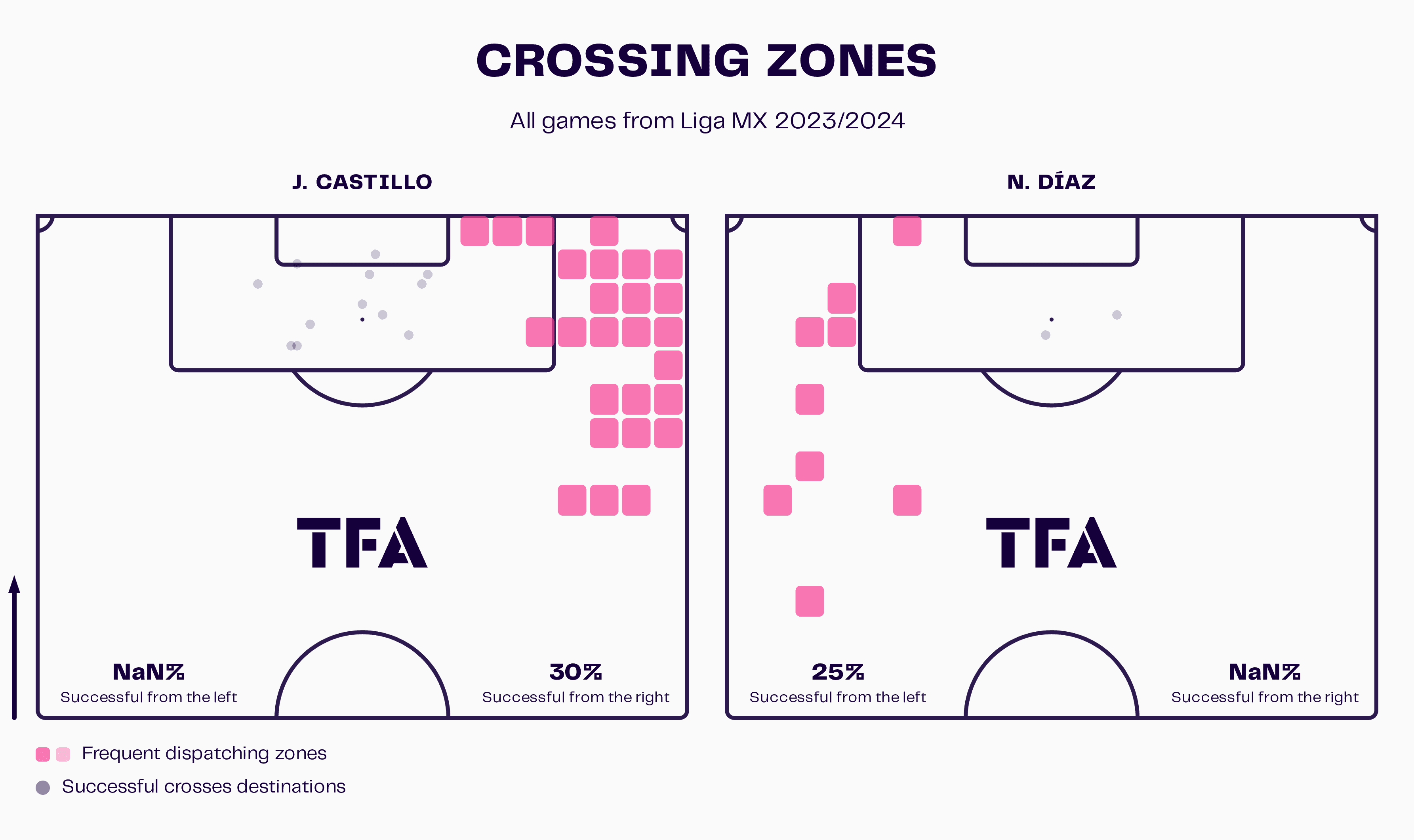
However, although Díaz is slightly more reserved going forward, he is versatile and can play as a left-sided centre-back. This facilitates an interchanging shape from a back three to a back four.
Whilst tackling credentials were deemed important for the full-backs, the reading of the game has been considered a strong threshold for centre-backs. One player who stood out for interceptions per 90 is 20-year-old Turk Emin Bayram, who is currently on loan at Belgian side Westerlo from Galatasaray.
In the Belgian Pro League, he has made 3.6 interceptions per 90 this campaign, the highest of all players to have featured for at least five 90s. The young Turk’s reading of the game is further exemplified by his play out of possession, as in the past 12 months, he has completed 20.71 counterpressing recoveries.
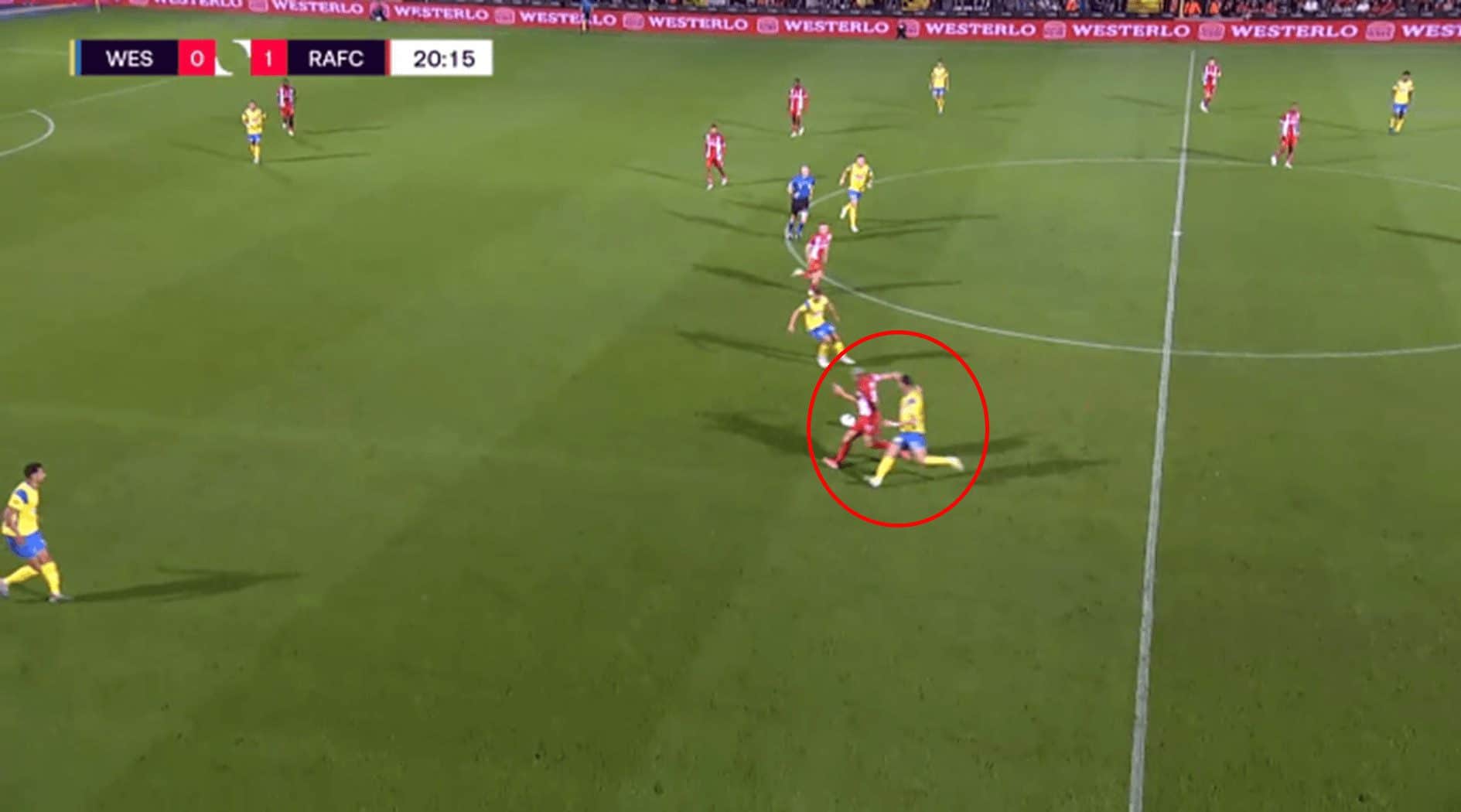
The image shows Bayram engaging in a fairly high press, and the consequent numerical advantage shown enables his side to win possession. His awareness to track the run of the opposition was rewarded.
Whilst Bayram could improve in the percentage of defensive duels won compared to his peers in the top three tiers, he does rank in the 95th percentile for a percentage of aerial duels won, suggesting his dominance in the air.
In addition to his defending credentials, he is just as comfortable in possession, looking to make dangerous passes forward. He ranks in the 93rd percentile this season compared to other right-sided centre-backs in tiers one, two, and three for dribbles per 90. His confidence in going forward with the ball demonstrates his composure in matches.
Bayram’s central defence partner in this team is just as comfortable in possession: 21-year-old Ukrainian Arseniy Batagov. Although a defender can be comfortable on the ball, it is how they use the ball which is important which brought our attention to Batagov, who ranked top of our analysis for line-breaking passes, averaging 2.4 per 90.
Batagov is a left-sided centre-back currently at Zorya Luhansk who, although a tier three side, have featured in this season’s Europa Conference League. For a defender, he does offer a lot to the attacking phases of play. His passing can sometimes miss the target, but this is a product of the type of passes he likes to make.
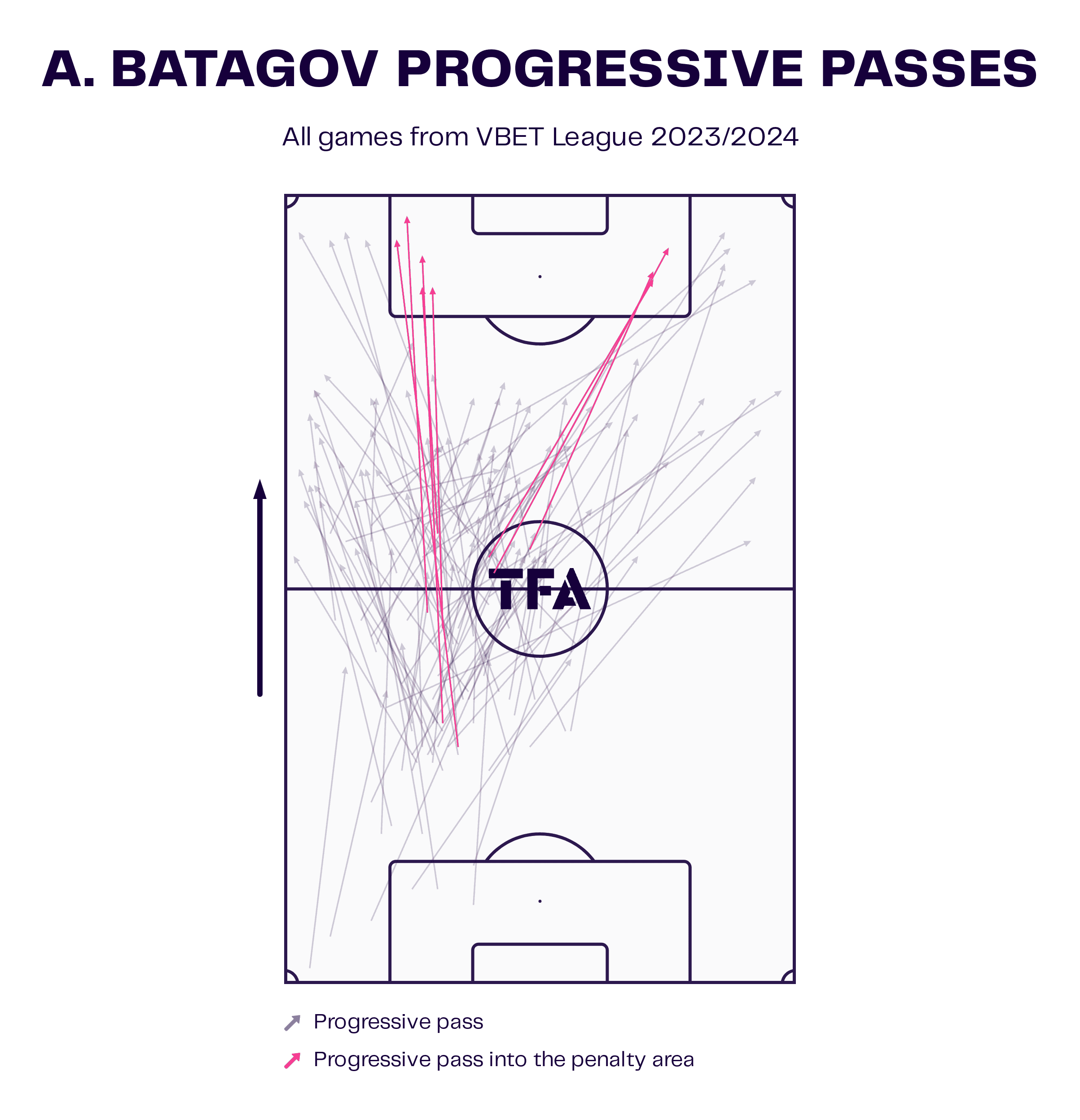
The graphic shows the types of progressive passes that Batagov likes to play. In addition to the line-breaking passes in the inside channel, he is just as strong switching the play. His possessional play is not too surprising, given he can also operate in defensive midfield as well as his primary defensive position. His versatility, therefore, gives him an edge as he may be able to adopt a hybrid role.
Batagov’s strengths are undoubtedly with the ball at his feet, but he does not shirk from his defensive duties. He ranks in the top 25% for the percentage of defensive duels won and defensive positioning among tiers two, three, and four left-sided centre-backs.
Midfield
Within the midfield three of this side is a single pivot in defensive midfield. The role of this midfielder is to protect the back line but also be an essential figure in transitioning play forward. The obvious criteria would be to look at how well such a midfielder can tackle and intercept the play, but we have also focused on their line-breaking pass credentials.
A player we identified was Boca Juniors Argentine Ezequiel Fernández. However, given the rumoured interest from Liverpool, he is believed to demand a high price tag. One player who stood out for their transitional play was 24-year-old Argentine Aníbal Moreno.
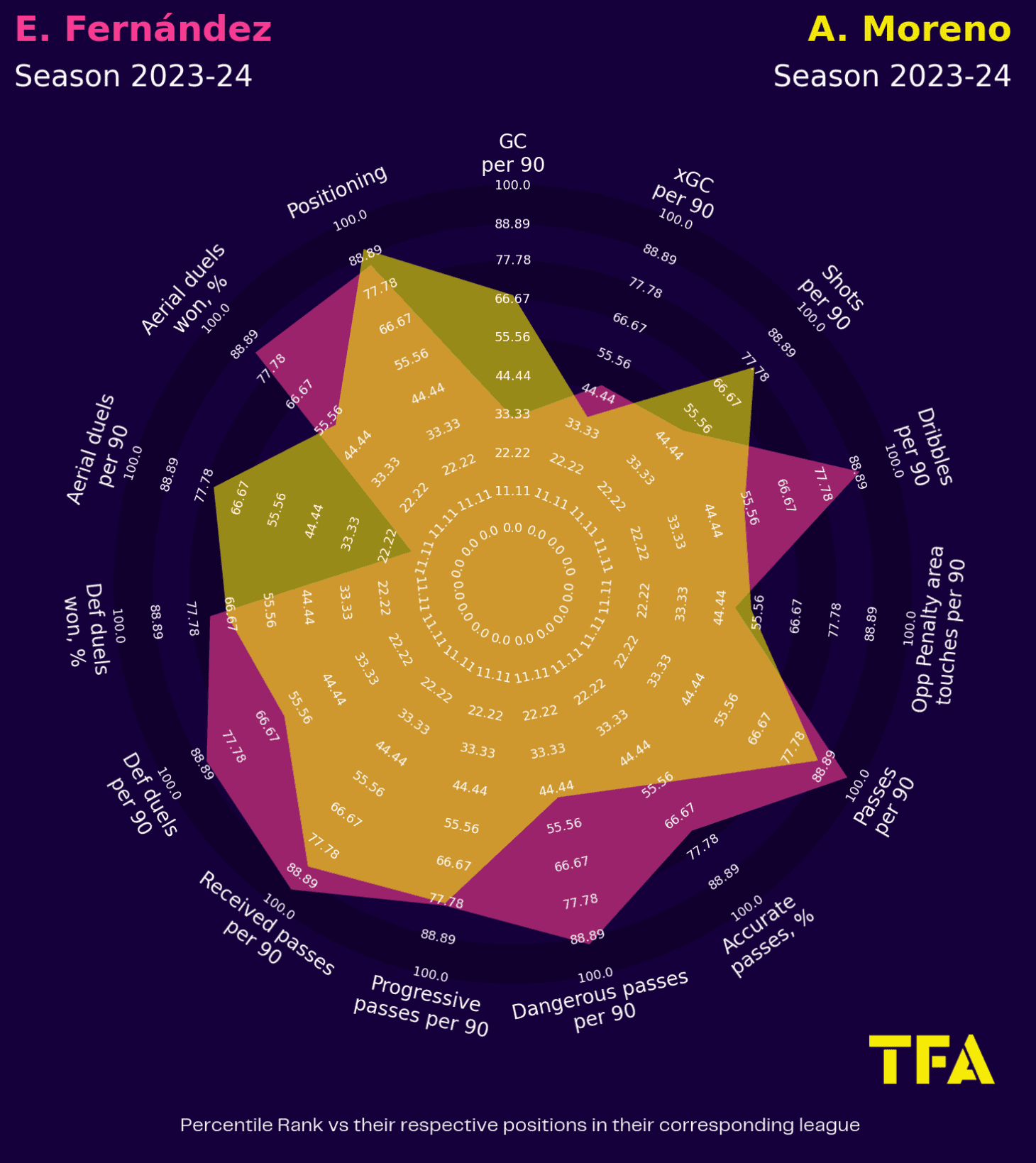
The radar chart shows the similarities between Fernández and Moreno. Although Fernández is slightly outperforming Moreno generally, Moreno is more of an attacking threat. Moreover, Moreno’s current market value is likely to be a snippet of the expected value of Fernández.
Moreno has strong positional play and is a progressive passer, looking to switch play to either flank as well as provide balls into the area. It is striking that in possession, he is very calm and composed, which enables him to make difficult long-range passes; he is also comfortable with ball progression into the opposing half. This suggests a strong ability to aid in attacking transitions as well as defensive cover.
With a single pivot in midfield, this allows the other two midfielders license to attack. However, it was a defensive statistic that brought our attention to the next midfielder who makes up this team, 20-year-old Brazilian Marlon Gomes. Gomes averages 2.6 interceptions per 90, the second-highest in Brazil’s top flight for players who have played at least five 90s.
Gomes’ intelligence ensures he ranks in the top nine per cent for defensive positioning among the top three tiers in football in his position. Although Gomes predominantly features on the left side of central midfield, he is also versatile and can play on the right, occupying the space in the inside channels.
The Vasco da Gama midfielder has a successful cross rate of 28.6% from either flank, further highlighting his versatility in the attacking phases. However, he is more prone to making runs into the penalty area for crossing positions on the right side of the box. This, therefore, makes him an ideal option in a 4-3-3 formation.
However, Gomes is not just restricted to playing this formation, as the box-to-box midfielder started his senior career fluctuating between different tactical approaches. Furthermore, he has featured in defence at youth level for the national team, highlighting his flexibility.
His style of play is synonymous with that of a box-to-box midfielder as he covers defensive duties across all thirds of the pitch and is a strong dribbler to aid in attacking transitions.
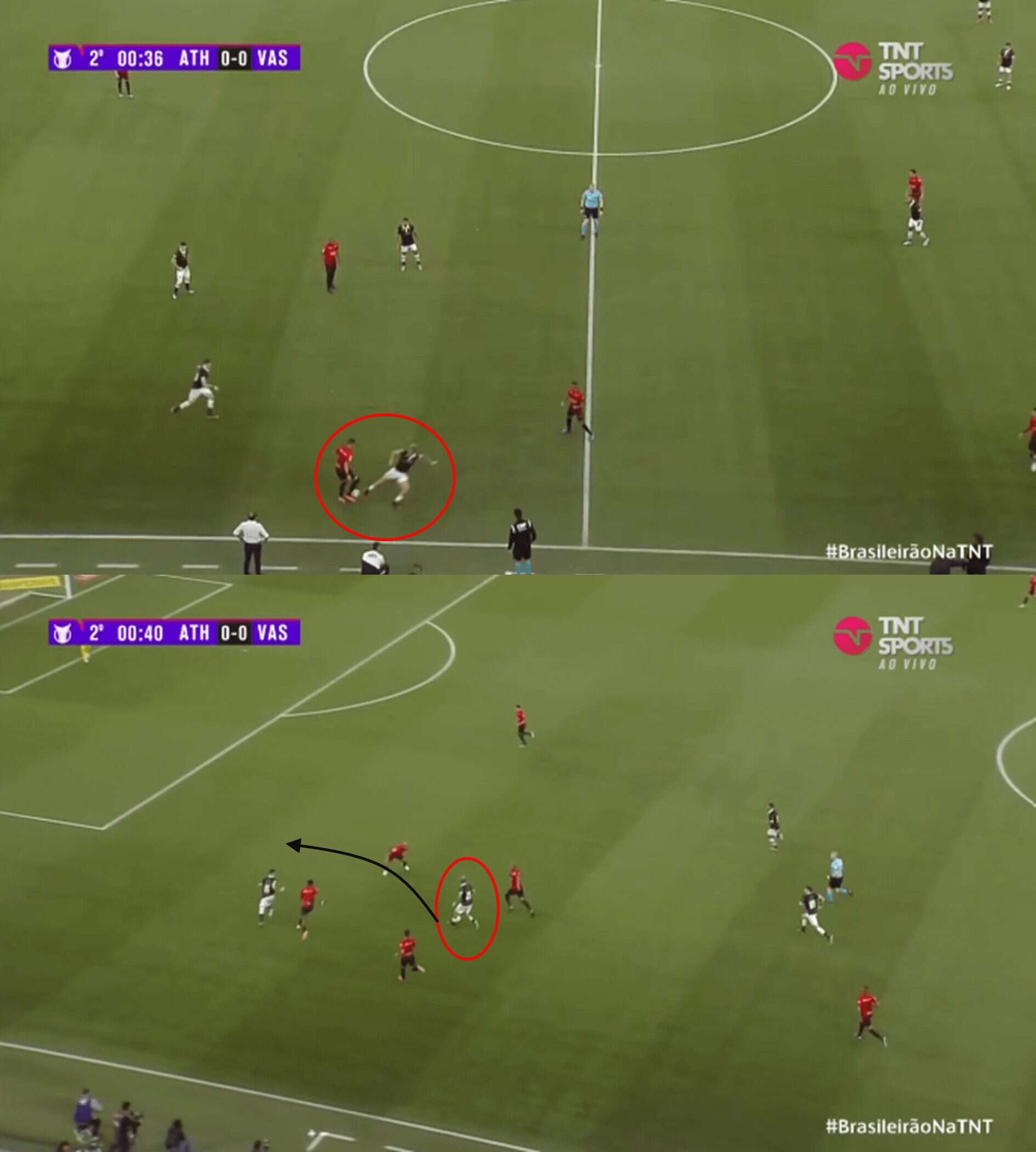
This is evident in the above example: upon successful tackling, Gomes advances before weighting a lofted through ball, and his side eventually wins a corner.
The young midfielder could certainly improve on his threat in front of goal as he did not score this season in Serie A and only registered one assist. However, his credentials as a box-to-box player cannot be ignored, and he would undoubtedly be a tireless engine in the heart of midfield. He has big potential, and his age is certainly on his side to develop the weaknesses in his game.
The final midfield spot in this team goes to 19-year-old Colombian Miguel Monsalve, who currently plays for Medellin in Colombia’s top flight. Monsalve is a creative outlet for this team, with three goals and three assists to his name this season. Monsalve made his debut at only 16 years old, having initially been invited to train with the first team at 13. This demonstrates the high regard that is thought of him.
Monsalve’s shot conversion rate of 23% ranks highly for attacking midfielders. Still, he also ranks highly compared to his peers in tiers two, three, and four for his possessional play and positioning in the final third. He averages 0.76 key passes per 90 and receives passes centrally, just outside the penalty area, at a rate of 5.8 per 90.
Taking up such positions facilitates the youngster to play dangerous passes in the final third.
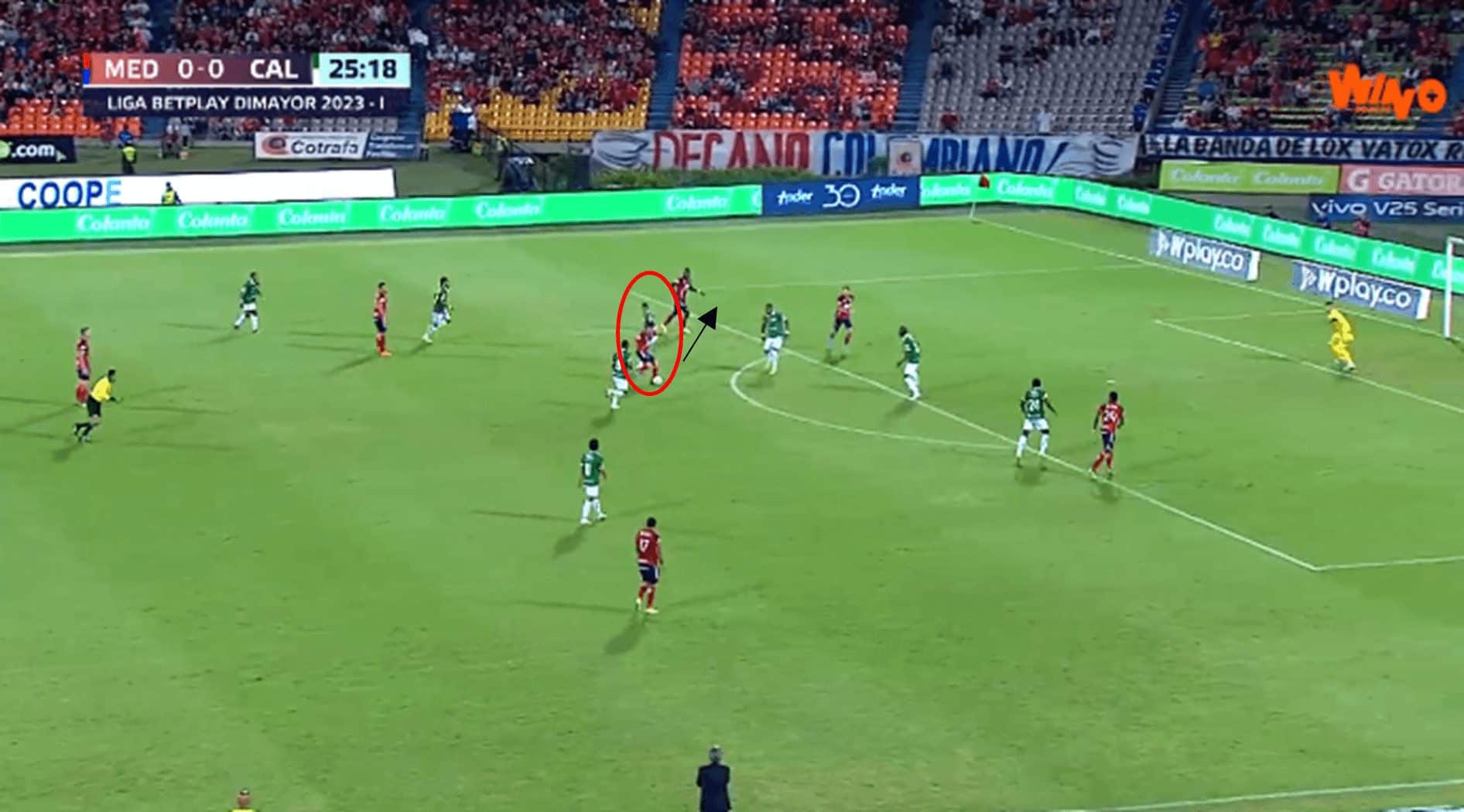
Here, Monsalve advances centrally and quickly shifts onto his right foot before picking out a pass to assist a goal whilst surrounded by the opposition. This demonstrates his attacking credentials and quick feet.
The teenager could improve the defensive elements of his game; however, he is strong aerially despite his relatively small stature. Nevertheless, Monsalve is a technically gifted player whose versatility in occupying space on the left channel as well as inside can cause problems. With the right guidance, he has a lot of potential.
Attack
The more apparent criteria in identifying forward players is to look at goals scored. However, this doesn’t paint a detailed picture of the forward is wasteful with their chances. Therefore, for this analysis, we have looked at efficiency in front of goal and identified Orlando City’s Duncan McGuire in the MLS.
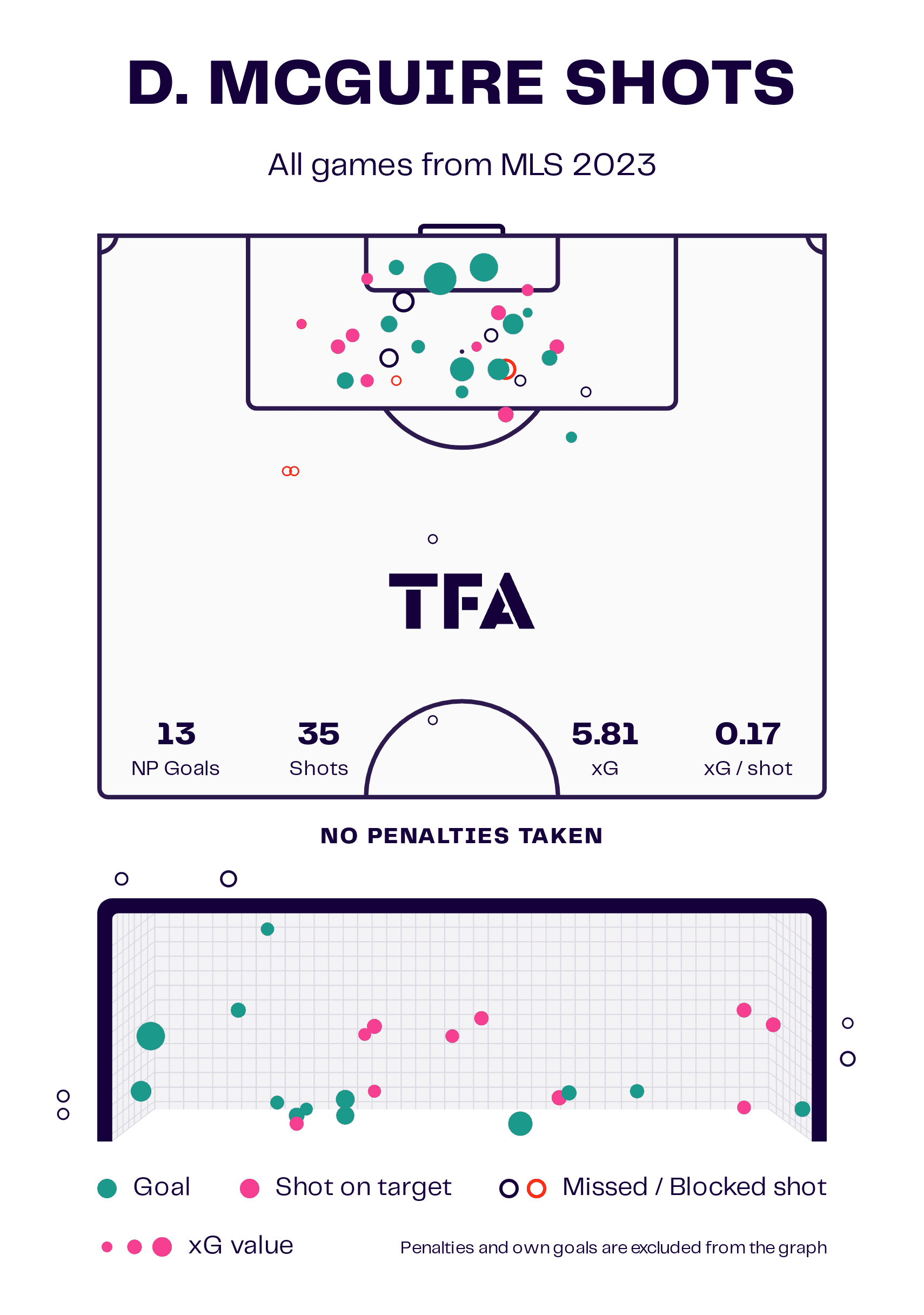
The graphic shows that McGuire has scored 13 non-penalty goals this season despite having only a 5.81 expected goals tally. While this could point to an overachieving player, he is a forward possessing confidence at present, as testified by his long-range effort near the halfway line on the above.
It is striking in the above graphic how potent McGuire is, regularly scoring from inside the area and having a tendency to be in the right place at the right time. This in itself is an art. The 22-year-old only recently made the step up from his college career, so there will be tactical aspects of his game that will need addressing. However, his potency cannot be ignored.
McGuire has converted 39% of his shots this season, suggesting his efficiency. Furthermore, 72.7% of his shots have hit the target. To put into context, last season’s most efficient forward in the Premier League was Nottingham Forest’s Taiwo Awoniyi, converting 29% of his efforts; Firmino had the largest shots-on-target percentage at 64.1%. McGuire is currently outperforming these statistics and could be worth a punt.
To complete the forward line-up are Club Brugge’s Antonio Nusa and Deportivo Cali’s Juan Córdoba. An obvious attribute in finding a winger is to look at their dribbling ability, but as well as this, we looked at high regains per 90 due to the prevalence of pressing in the modern game. This criterion unearthed the importance of Nusa, who averages 1.2 high regains per 90 and 3.1 dribbles per 90 in the last 12 months.
The 18-year-old left-sided forward also averages 5.81 shot-creating actions per 90, the third highest in the Belgian Pro League this campaign. This metric is vital for wingers as it shows their importance in the overall attacking outlet, instigating moves forward.
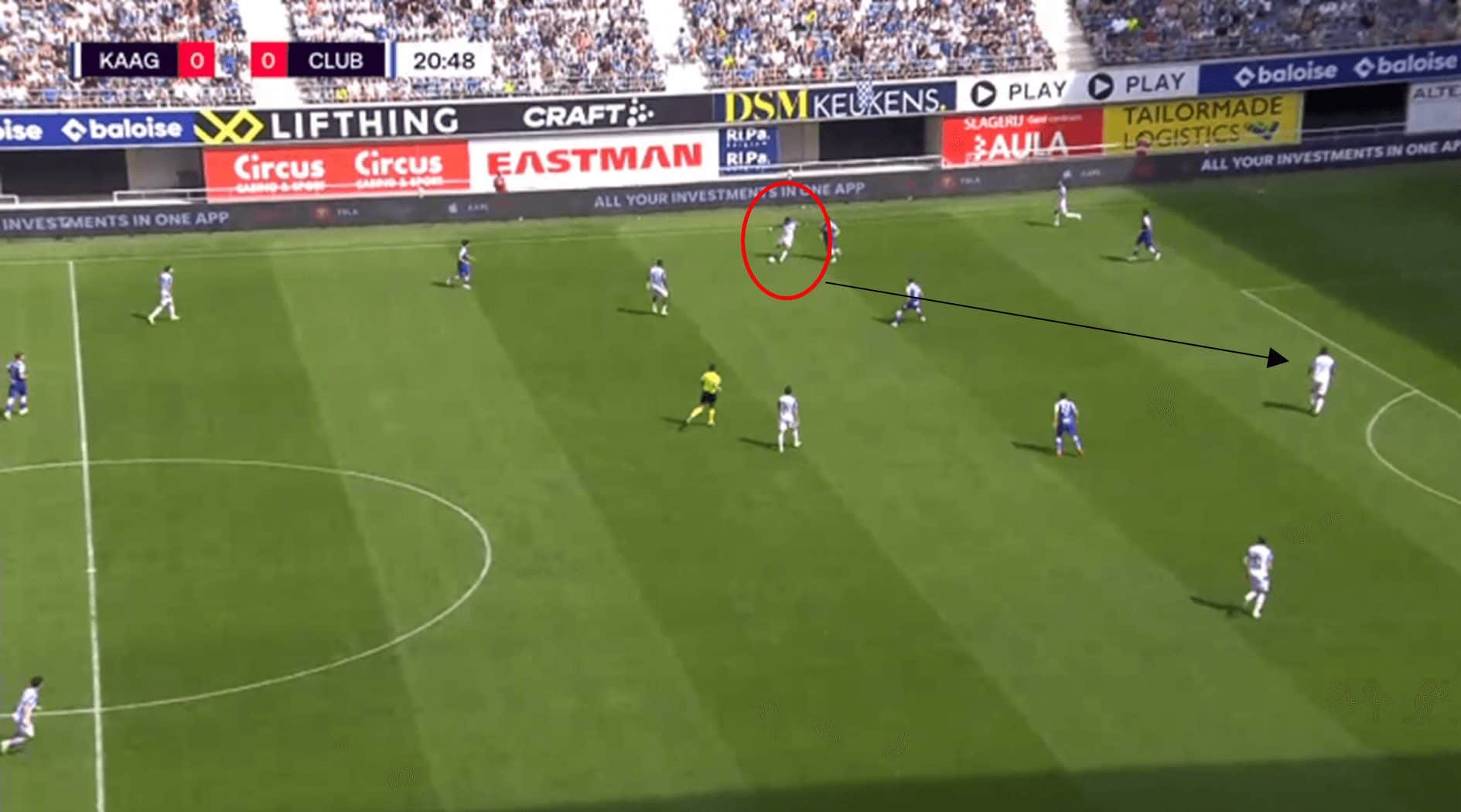
The above shows attacking involvement from Nusa as he plays a pass forward into the penalty area when the more obvious choice may have been to advance down the channel. It shows his vision for a pass in the attacking third.
Meanwhile, Córdoba completes one high regain per 90. The 20-year-old Colombian is comfortable dribbling, but his possessional play is his strength: the ability to pick out difficult passes. He can also be unselfish, as demonstrated below.
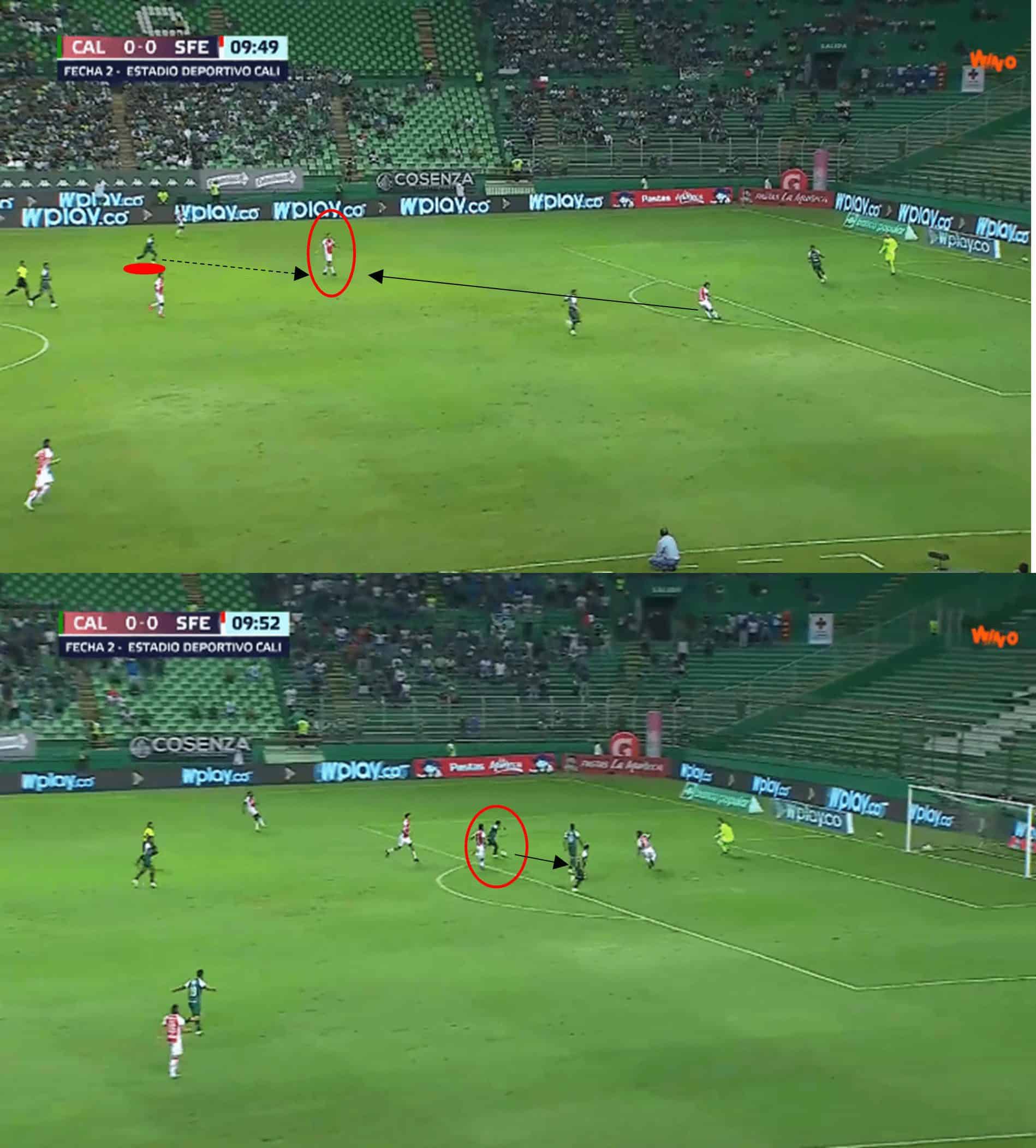
Córdoba has the awareness to inject speed as the opposition plays out from the back. He subsequently intercepts the pass and, despite the option to shoot himself, squares the ball to his teammate to fire a shot away.
Both wingers have scope to improve defensively despite their high regain quality. Although Córdoba is effective in the air, ranking in the 72nd percentile for percentage of aerial duels won in tier four. Like the others who make up this team, he is a raw talent with the potential to be developed.
Conclusion
In this data analysis and condensed scout report, we have highlighted a starting XI made of individual talent with enormous potential based on statistics. Whilst there is no guarantee that these identified players will make the grade, there is scope for development. It will be interesting to track their career paths.






Comments